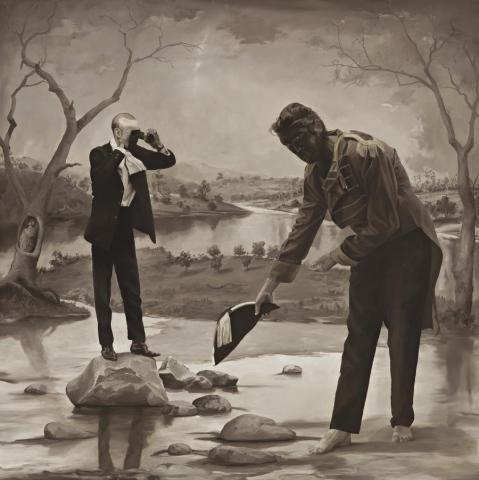THE PROMISE, THE INEVITABLE DISAPPOINTMENT, 1989
STEPHEN BUSH
oil on linen
182.5 x 182.5 cm
signed, dated and inscribed verso on stretcher: Stephen Bush 21/3/89 – 14/4/89 The Promise – the inevitable disappointment
Powell Street Gallery, Melbourne (label attached verso)
The John L. Stewart Collection, New York
Claiming: An Installation of Paintings by Stephen Bush, Australian Centre of Contemporary Art, Melbourne, February – March 1991; Contemporary Art Centre of South Australia, Adelaide, April 1991; The Aldrich Museum of Contemporary Art, Ridgefield, Connecticut, September 1991 – January 1992, cat. 6
Cass, N., Claiming: An Installation of Paintings by Stephen Bush, Australian Centre of Contemporary Art, Melbourne, 1991, p. 11 (illus.)
Among the artist's earliest work, The Promise, the Inevitable Disappointment, 1989 engages one of Bush's favourite artistic tropes. Employing monochromatic colour and figurative realism, Bush indicates to his audience that this painting draws directly from history and illustration. In the artist's words:
'When I paint pictures in colour there are all these other things to consider. You end up involving yourself in the mechanics of the picture. The monochrome pictures were inspired by looking at old illustrations in catalogues where you just get a graphic impression. This relates to black and white photography and television - where you just look at the image. You are not concerned with 'beauty' or colour. You look at the image but at the same time your mind is telling you that the sea is blue, not grey.'1
In this ambiguous visual narrative, Bush alludes to several celebrated characters in the history of Australia's colonisation. Set in inimitably Australian bushland, we encounter two eccentric figures, both seemingly at odds with their surroundings. Balancing on a large rock, a navigator immaculately dressed in modern attire surveys the foreign landscape. In the foreground a bare-footed man painted in black-face "donning an elaborate European costume that recalls a uniform donated to Aboriginal explorer and entertainer Bungaree bows forward with his hat, welcoming us to his land. As is common for the artist, he paints himself seamlessly into the composition, here in the form of the native protagonist.
The Coolibah tree in the background is carved with the initials 'ROB', for Robert O'Hara Burke "referencing numerous depictions of Australian explorers Burke and Wills who set off in 1860 full of optimism with the intention to navigate Australia, and ended up starving to death in the harsh desert landscape after refusing the help of the local Indigenous people. The tree in Bush's painting is in fact a real landmark turned tourist destination on the banks of the Diamantina River in Queensland which was purportedly engraved by the explorers as they passed through the region. The Bungaree character in the foreground of our painting may well be a reference to John King, the only member of the Burke and Wills party to survive after he made friends with an Indigenous community and took guidance from them in hunting and other imperative survival skills.
In our image Bush alludes to the idea of historical accuracy through black and white documentation, but this facade belies the wry absurdity of the image. When we look closely, we see a joke that sums up so much 19th century historical painting and journalism: the heroic explorer whose journey promised great riches and rewards, yet in reality delivered only tragedy and disappointment.
1. Stephen Bush, cited in Cripps, P., Stephen Bush and Janet Burchill, exhibition catalogue, The Lewers Bequest and Penrith Regional Art Gallery, Emu Plains, New South Wales, p. 7
LEAH CROSSMAN
